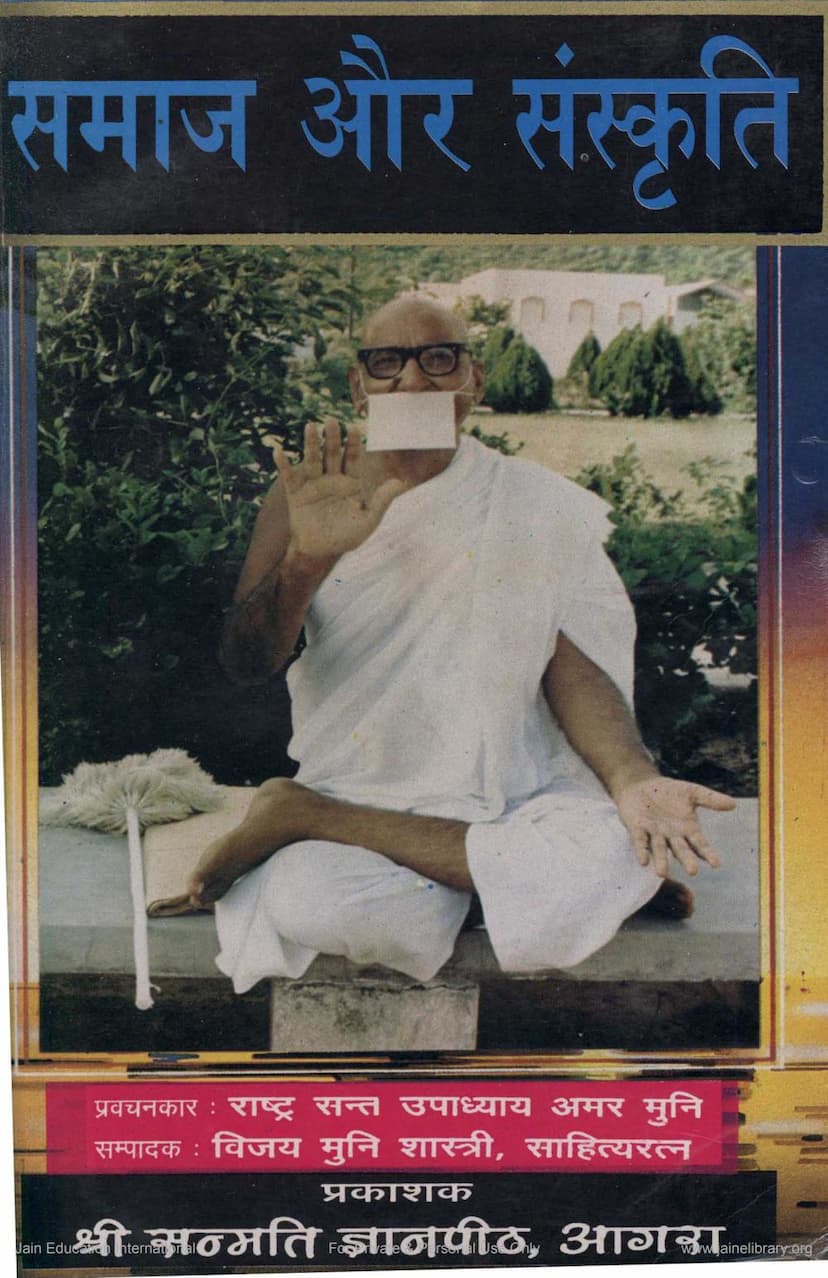Samaj Aur Sanskruti
Added to library: September 2, 2025

Summary
Here's a comprehensive summary of the Jain text "Samaj aur Sanskruti" by Amarmuni, based on the provided pages:
Book Title: Samaj aur Sanskruti (Society and Culture) Author: Amarmuni (referred to as Rashtra Sant Upadhyay Amarmuni, and also as Upadhyay Amarchandji Maharaj) Publisher: Shri Sanmati Gyan Peeth, Agra
Overall Theme: The book is a collection of discourses by Amarmuni on the interconnected themes of society and culture. It delves into the fundamental aspects of human life, individual development, societal harmony, and the principles of Jainism that guide them. The central idea revolves around understanding oneself, one's place in society, and the underlying principles that shape both.
Key Concepts and Themes Explored:
-
The Nature of Society and Culture:
- Society: Discussed as a fundamental necessity for human existence, where individuals are born, nurtured, and develop. The importance of recognizing and honoring society's power is emphasized.
- Culture: Defined as a vast element encompassing human life, harmonizing intellect (buddhi), heart (hriday), and behavior (vyavahar). It is seen as a treasure trove containing philosophy, ethics, science, and art. Culture involves looking outwards (science), inwards (philosophy), and upwards (religion).
-
The Individual and Self-Reliance:
- Human Potential: Humans are considered the most superior creation, possessing immense inner power. True strength lies in mastering one's mind.
- Self-Discovery: The ultimate goal is to "know yourself." One's potential and purity reside within, not in external places or deities. Relying on others for one's destiny is a sign of misfortune.
- Consciousness and Thought: The mind is the creator of one's life and destiny. Human potential is derived from inner thought and will (Sankalp-shakti).
- Inner vs. Outer: The book stresses the importance of introspection ("closing the outer doors and opening the inner doors") for gaining true knowledge and peace of mind.
-
The Importance of Purpose and Action:
- Living with Purpose: Life is meaningful when lived for a purpose, not just for survival.
- Right Action: Every action should be considered for its intent and impact on oneself, society, and the nation. Unjust or unethical actions erode personal and collective strength.
- Self-Improvement: Continuous effort and inner awakening are necessary for personal and societal progress.
-
The Role of Intellect, Emotions, and Ethics:
- Harmony: True culture lies in the harmony between knowledge (jnana), emotion (bhava), and action (karma).
- Mind as the Center: The mind is the focal point of spiritual practice (Sadhana). A peaceful and focused mind is crucial for knowledge acquisition.
- Morality: Actions should be judged as good or bad, right or wrong, beneficial or detrimental.
-
Jain Principles and Philosophy:
- Ahimsa (Non-violence): Central to Jain culture, practiced in thought, word, and deed. It's the foundation for all other virtues.
- Anekanta (Non-absolutism/Manysidedness): The principle of understanding truth from multiple perspectives, leading to tolerance and broader understanding. This is presented as the intellectual counterpart to Ahimsa.
- Karma: The concept of karma is elaborated upon, emphasizing that individuals are the creators of their own destiny through their actions. The book explains karma as a subtle entity that influences life's experiences.
- Soul (Atma): The soul is described as the true, eternal, and intrinsically pure essence of a being, distinct from the physical body and its transient states. The goal of spiritual practice is to realize this soul-nature.
- Nirvana/Moksha: The ultimate liberation from the cycle of birth and death, achieved through self-realization, ethical conduct, and spiritual discipline.
- Right Faith, Right Knowledge, Right Conduct (Samyak Darshan, Samyak Jnana, Samyak Charitra): These are presented as the core tenets for achieving liberation, forming the path to Moksha.
- Rejection of Extremism: Jainism, as presented in the book, is not an extremist philosophy. It advocates for a balanced approach (Nirativada) rather than extreme asceticism or indulgence.
-
The Nature of Man and Divinity:
- Inner Divinity: Humans are inherently divine. This divinity needs to be awakened through self-awareness and spiritual practice.
- The Mind: The mind is a powerful tool, capable of both creation and destruction. It's likened to a Kalpavriksha (wish-fulfilling tree) where thoughts and intentions manifest into reality.
-
Social Responsibility and Harmony:
- Interdependence: Individuals are interconnected within society. The development of one contributes to the development of all.
- Ethical Conduct: Living ethically and with a sense of duty towards society is paramount.
- Contribution to Society: True development comes from contributing to society, not by isolating oneself.
-
The Importance of Inner Transformation:
- Discipline of the Mind: The book consistently emphasizes the need to control and purify the mind, as it is the source of both bondage and liberation.
- Habits and Character: Habits shape character, and character determines destiny. Cultivating virtuous habits is crucial.
- Detachment: Overcoming attachment to material possessions, worldly pleasures, and even the physical body is essential for spiritual progress.
-
Illustrative Narratives and Examples:
- The text uses stories and parables, such as the story of Hanuman and Rama, Trishanku, and the discussion about the nature of a true devotee, to illustrate its points. The narrative of King Shrenik and his devotion is also used to highlight the transformative power of spiritual practice.
- The contrast between Western and Indian philosophies on culture and materialism is also touched upon.
-
The Concept of "Sakshatkar" (Realization):
- The book highlights that true understanding comes from experience and realization rather than mere intellectual pursuit.
Structure and Style: The book is compiled from discourses, maintaining an oratorical and instructive tone. The editor, Vijay Muni Shastri, is credited with simplifying the language and enhancing the style of the original speeches, making them accessible to a wider audience.
In essence, "Samaj aur Sanskruti" is a profound exploration of how individuals can live a meaningful life by understanding their inner potential, cultivating ethical conduct, contributing positively to society, and adhering to the spiritual principles of Jainism, particularly Ahimsa and Anekanta, for ultimate liberation.